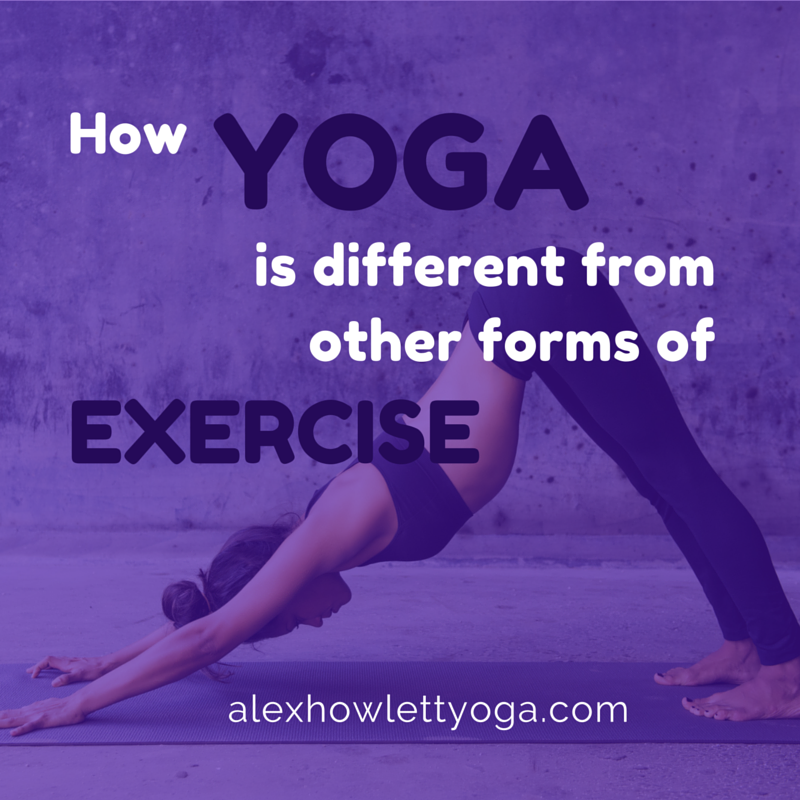
What does the word yoga mean to you? You might think yoga is just stretching. Or, maybe some images come to your mind of people in crazy, bendy, gymnast positions and arm balances. Yes, yoga involves moving the body into specific postures, or asanas, but yoga is different from other forms of exercise. How so?
How Yoga is Different from Other Forms of Exercise:
Yoga is a form of moving meditation.
With the asanas, we improve our health and build strength, balance and flexibility. The physical practice of yoga also touts benefits such as weight loss, healing from injury, releasing endorphins and reducing stress. But in yoga, we don’t just focus on the body, we focus on the mind-body as a whole. In most yoga classes, we combine the movement with meditation. We focus on connecting with the breath to let go of worries and negative thoughts, set intentions and close the class by meditating in savasana (corpse pose).
Want to make your class more meditative? Focus on your intention throughout class, or choose a few affirmations and repeat them to yourself as you move into and out of asanas. Some examples of uplifting affirmations are: “I am powerful.” “I live in the present moment.” “I love and accept who I am.” Choose affirmations that resonate with you. You can also use them during sitting meditations or any other time outside of your yoga practice.
There are EIGHT limbs of yoga; asana is just ONE of them.
Patanjali’s Yoga Sutras, written about 2000 years ago define ashtanga, or ” the eight limbs of yoga.” According to this ancient text, the path to true yoga, meaning “union,” is to practice these eight steps, one at a time, until reaching enlightenment, the final step. We won’t go into depth about the eight limbs in this post, but in short summary they are:
- Yamas: Universal moralities (compassion for all living things, truthfulness, non-stealing, self control, lack of greed)
- Niyamas: Personal observances (inner and outer cleanliness/purity, contentment with what we have, disciplined use of energy, self reflection, celebration of the spiritual)
- Asanas: Body postures
- Pranayama: Breathing exercises, balancing the prana (life force)
- Pratyahara: Control of the senses/non-attachment to sensory distractions
- Dharana: Concentration – focusing attention in one direction, stilling the mind
- Dhyana: Meditation on the Divine – questioning the nature of things to lift the illusions that cloud our mind, letting go of fears and unhappiness to find freedom
- Samadhi: Union with the Divine/the Universe, ending the separation created by the ego, entering a state beyond consciousness, pure bliss
Yoga is a spiritual practice meant to free us from distractions connect us with all that is.
Have you ever heard someone say that yoga has transformed their life? That’s why so many people can’t get enough of it. By observing and practicing the eight-fold path listed above (or even just some components of it), we can find happiness. Yoga helps us to be mindful of other people and living things, be aware of the spiritual rather than just the material world, release fears and negativity, boost confidence and just feel good overall.
For me, the relaxing and meditative aspects of yoga helped bring me out of a very dark time in my life so I could start enjoying life again. That’s what inspired me to become a teacher. Do I strictly follow the eight limbs of yoga? Nooope! I believe we’re all free to choose our own path, and should do so, but the guidelines set by others before us can be good starting points. But that’s just my opinion. Yoga has most definitely helped me to start FINDING THE HAPPINESS WITHIN MYSELF, and it can most likely help you, too.